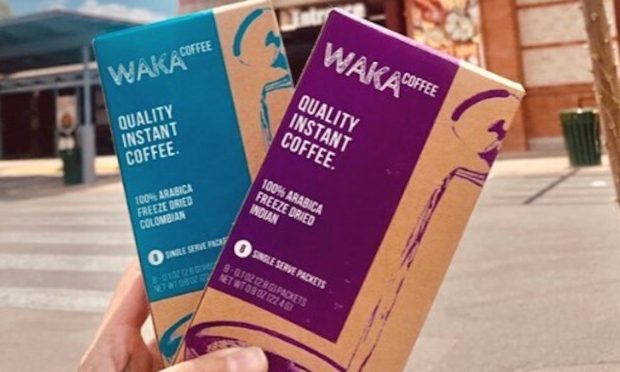Instant Coffee Brands Brew Rapid Gen-Z Growth

As consumers come to expect on-demand convenience without sacrificing quality, many food and beverage brands and retailers have been developing a following by promising the best taste for the least amount of prep or wait time. Grocers have been driving sales with prepared meals, delivery services have been building a following with short delivery times, and now — to the horror of those who grew up with Sanka — instant coffee is making a comeback with young consumers.
Premium instant coffee brand Waka Coffee, for one, has built a following through both its direct-to-consumer (D2C) online shop — which sells individual products and monthly subscriptions — and its third-party e-tailers Amazon and Walmart.com. Earlier this summer, the brand launched brick-and-mortar for the first time.
You might also like: Bean Box On Its Product-Driven Approach To Subscriber Retention
“Instant coffee gained a lot of popularity during 2020 — the category actually grew almost double the rate of the overall coffee category,” Waka Coffee’s Founder and CEO David Kovalevski told PYMNTS in an interview. “More people drink coffee at home. They want it easy, consistent, delicious … and more people [are] adopt[ing] instant coffee as their main coffee method.”
When PYMNTS spoke to Kovalevski back in January 2020, he said he was struck by the difference “between what instant coffee can be and the offerings that were available at the time.” Since then, the brand’s following has soared.
Learn more: Delivering Caffeinated Innovation Through eCommerce
While the rise of instant coffee was accelerated by the pandemic, reports indicate that the category will continue to grow. A Technavio study finds that the global market will grow 4.3 percent in 2021, and that this annual growth rate will increase in the next few years, with the market growing a total of $9.3 billion through 2025.
Kids These Days
While instant coffee remains popular in many countries, the product has a reputation in the United States of tasting significantly worse than brewed coffee. Sales have plummeted since the beverage’s peak popularity in the U.S. in the 70s.
Younger consumers who are not as privy to this history, however, are something of a blank slate, more open-minded to today’s new instant coffee varieties. Kovalevski said that Gen Zers are over-indexed in the category, and that the leading brands are not yet tapping into this demand.
“We see that the big brands are not necessarily approaching this segment of consumers, and we see a huge opportunity to bring new consumers to the category,” he explained. “For them, instant coffee is this new, innovative product. They haven’t seen it before … for them, it’s coffee magic.”
Kovalevski noted that the demographic shift toward younger consumers has occurred just in the last several years, and especially since the start of the pandemic.
The Dalgona Coffee Craze
As with so many trends popular with Gen Z, part of instant coffee’s early-pandemic surge in popularity was due to a viral TikTok craze. In the early months of the pandemic, a recipe started circulating around TikTok that explained how to recreate a drink that appeared in a popular South Korean food-based television series.
The drink, “dalgona coffee” or “whipped coffee,” is made with instant coffee, water, sugar and milk. It gained widespread social media popularity in March, and by April, it had hit many mainstream news outlets. By monitoring Google and social media trends, among others, Waka Coffee was able to capitalize on the trend, building a following with fans of the beverage.
“We recognized the trend really early on,” said Kovalevski. “We created content — videos, blog posts, tutorials — and we were actually first on Google for ‘dalgona coffee’ and ‘whipped coffee’ when the trend first started.”
This wave helped drive the company’s success throughout the pandemic, with sales ultimately growing four- or five-fold from the year before.
…and Beyond
While the surge in sales started early in lockdown, Kovalevski believes that instant coffee will remain popular even as mobility increases. He noted that it’s an easy beverage to bring on the go, that people have grown used to making coffee at home, and that many consumers are continuing to work from home more than before the pandemic.
In fact, PYMNTS data from a March study, “The New Digital Consumer: How The Pandemic Has Reshaped Consumers’ Shopping Behaviors,” found that 39 percent of all consumers have shifted to working from home instead of in an office, and 83 percent of those consumers intend to keep working from home at least somewhat as often as they do now, even once they are cleared to return to the office.
Deep dive: The PYMNTS COVID Data Compendium: The Past, Present And Future Of The New Digital Consumer
As Waka Coffee moves into brick-and-mortar stores, Kovalevski noted that the company “want[s] to make changes to our packaging” to provide some of the brand education that the company can present on an online product page. He added that the in-store shelf placement will make online consumers more receptive to digital advertising and that the company’s continued digital efforts will make in-store shoppers more aware of the product when they encounter it.
Looking ahead, he said, “We’re still … scratching the surface online, so we want to increase our online awareness. We want to make sure that we hit on those goals of bringing new younger consumers to the category, innovating in flavors, new SKUs that we are working now in the pipeline, expanding our subscription base … [and] bringing [instant coffee] to more US consumers.”
